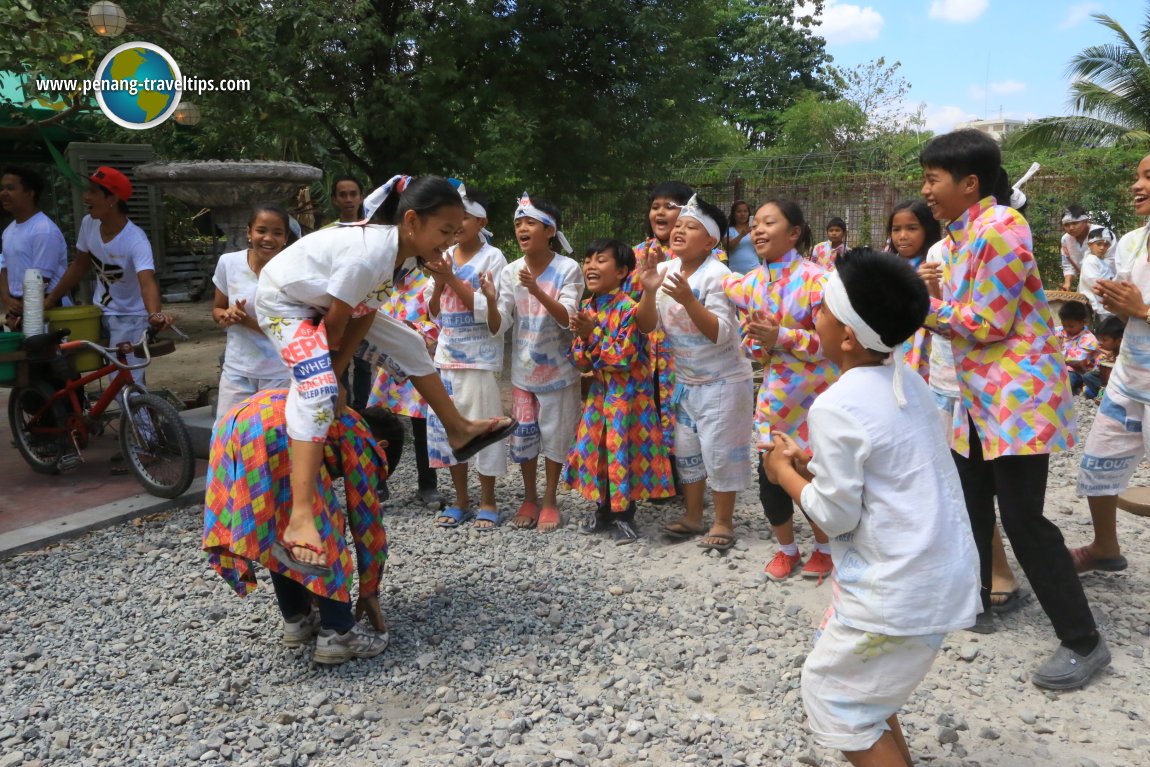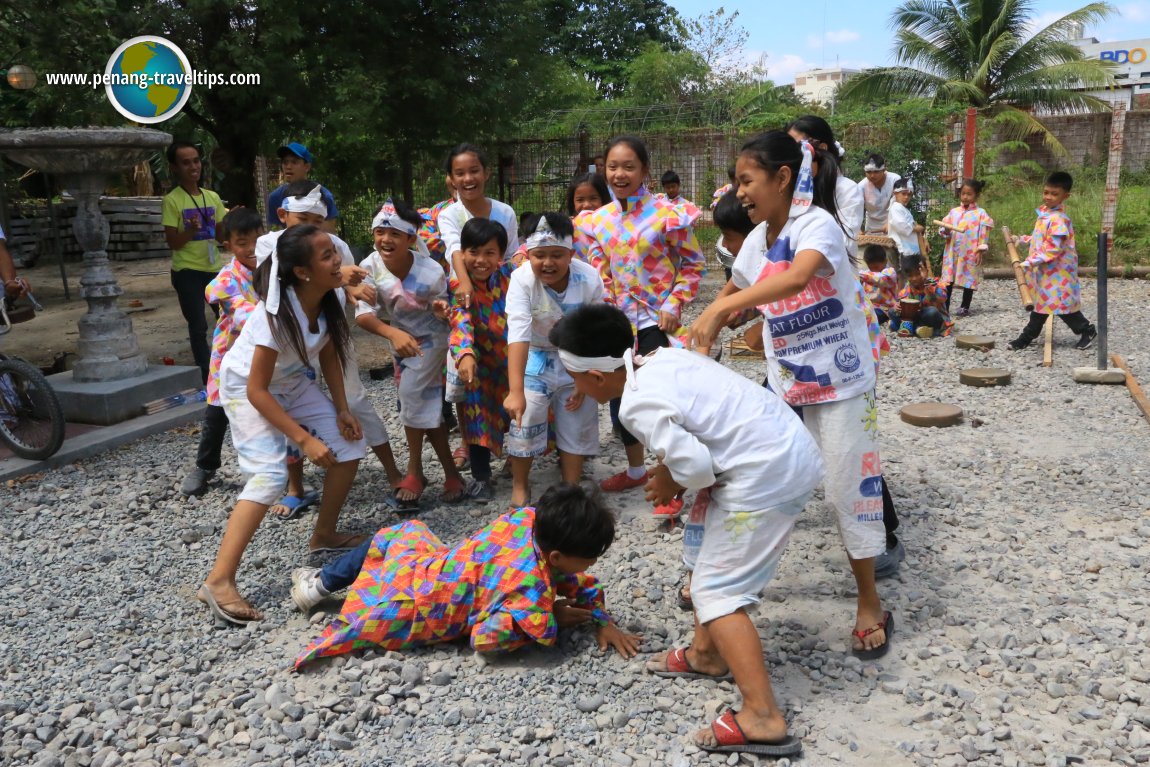
 25 Seeds, Angeles, Philippines (4 April, 2017)
25 Seeds, Angeles, Philippines (4 April, 2017)
25 Seeds (GPS: 15.13611, 120.58877) is a boutique restaurant in Angeles City, in the province of Pampanga, on the island of Luzon, in the Philippines. It is established by Philippine celebrity chef, Sau del Rosario, and is housed in a historic building, Dycaico Ancestral House, at 2F, Sto. Rosario Street. The house has been abandoned for over a decade before Chef Sau chanced upon it.
It took Chef Sau much consideration before he decided to go ahead to establish 25 Seeds, which is his second restaurant in Angeles City, after Café Fleur, which he established earlier, at 463B Miranda Street, also in the Barangay of Sto. Rosario.
Asked how he arrived at the name 25 Seeds, Chef Sau that when the restaurant was being conceptualized, he was working with the surrounding farmers to plant twenty-five different seeds of indigenous plants and herbs, to cater to the needs of the restaurant, and that's how he decided on the name.
 25 Seeds, Angeles, Philippines (4 April, 2017)
25 Seeds, Angeles, Philippines (4 April, 2017)
 Upon our arrival, we were greeted by this Filipina lass in traditional costume (4 April, 2017)
Upon our arrival, we were greeted by this Filipina lass in traditional costume (4 April, 2017)
Today 25 Seeds restaurant occupies the upper floor of the heritage building, while a local bank the ground floor. On the day of our visit, we saw that there was some kind of mini fiesta happening on the grounds. Apparently, the local people and children would gather here in the afternoon, to reenact various folk games and dances. By their action, I believe some of these games are based on local tales and folklore which I know nothing about.
Filipino Traditional Folk Games
 Filipino children playing, on the grounds of 25 Seeds restaurant, in Angeles, Philippines (4 April, 2017)
Filipino children playing, on the grounds of 25 Seeds restaurant, in Angeles, Philippines (4 April, 2017)
 Filipino children playing (4 April, 2017)
Filipino children playing (4 April, 2017)
 Filipino children playing (4 April, 2017)
Filipino children playing (4 April, 2017)
 Filipino children playing (4 April, 2017)
Filipino children playing (4 April, 2017)
 Tug-of-war between a white team and a multi-color team. (4 April, 2017)
Tug-of-war between a white team and a multi-color team. (4 April, 2017)
While the children were playing, another group was providing some form of music in the background. I saw all sorts of drums, gongs and bamboo xylophone. Their clothes are so colorful.
 Filipino children musical troupe (4 April, 2017)
Filipino children musical troupe (4 April, 2017)
 Filipino children musical troupe (4 April, 2017)
Filipino children musical troupe (4 April, 2017)
Filipino Traditional Snacks and Drinks
In addition to being entertained with a demonstration of the Filipino folk games by the children, we were also served various traditional snacks. One of them, the puto kutsinta, looks a lot like kuih kosui in Penang, Malaysia, offering a clue to possible Hokkien influence in these two very distant places. Also, the name "puto" corresponds with "putu", the rice-flour cakes by the Indians in Penang. Volunteers manning the Puto't Kutsinta stall at 25 Seeds (4 April, 2017)
Volunteers manning the Puto't Kutsinta stall at 25 Seeds (4 April, 2017)
 Puto't Kutsinta (4 April, 2017)
Puto't Kutsinta (4 April, 2017)
 Puto't Kutsinta in the foreground, and (4 April, 2017)
Puto't Kutsinta in the foreground, and (4 April, 2017)

Beancurd in brown sugar syrup, the same as available back home. (4 April, 2017)

Eating Balut
Balut is one of the food from the Philippines which outsiders would consider as "acquired taste". Itg is the half-developed embryo of duck or chicken while it is still inside the egg. The egg is then boiled and eaten while the half-developed embroyo is still inside.I have a chance to eat balut when I visited Chef Sau de Rosario's restaurant 25 Seeds. It was one of the traditional items being served to us international bloggers. I was game to try it. You would eat it with a bit of salt.
And how does it taste like? Well, somewhere between a hard-boiled egg and chicken meat. After eating one whole balut, I felt very full, but it didn't make me want to throw up. Rather, it made me wonder, why eat something like this. I think I would stick to eating eggs or chicken/duck, rather than something in the midst of transition.
 This school girl is handing out balut to anybody who dares to try. (4 April, 2017)
This school girl is handing out balut to anybody who dares to try. (4 April, 2017)
 Timothy Tye eating Balut in the Philippines (4 April, 2017)
Timothy Tye eating Balut in the Philippines (4 April, 2017)
 Timothy Tye eating Balut in the Philippines (4 April, 2017)
Timothy Tye eating Balut in the Philippines (4 April, 2017)
 Timothy Tye eating Balut in the Philippines (4 April, 2017)
Timothy Tye eating Balut in the Philippines (4 April, 2017)
Pushing the Envelope
How do we nurture traditional dishes and usher them down the road into future generations? There are two schools of thoughts. One is to preserve the traditional recipes as they are. The other is to creatively fuse elements from traditional recipes with cuisines from other parts of the world.Going by the latter path is Chef Sau de Rosario, a Filipino celebrity chef who is constantly pushing the envelope of creativity. At the risk of horrifying the traditionalists, Chef Sau has created wonderful dishes that celebrates the best of Filipino cuisine, with touches from other elements. One of the dishes that he was very excited about is his Sisig Paella, which uses the sisig, possibly the most well-known Filipino dish, with the paella, the Vanecian rice dish. During our visit to 25 Seeds, Chef Sau personally demonstrated the cooking of this dish, to everybody's delight. We then dig in to this and many other Filipino dishes.
 Chef Sau preparing the Sisig Paella (4 April, 2017)
Chef Sau preparing the Sisig Paella (4 April, 2017)
 The Sisig Paella takes centrestage among Filipino dishes Chef Sau has prepared for us. (4 April, 2017)
The Sisig Paella takes centrestage among Filipino dishes Chef Sau has prepared for us. (4 April, 2017)
 My plate of the Sisig Paella. (4 April, 2017)
My plate of the Sisig Paella. (4 April, 2017)
 Pancit Luglug, at 25 Seeds (4 April, 2017)
Pancit Luglug, at 25 Seeds (4 April, 2017)
 Refreshing lemonade was served to go with the Sisig Paella. (4 April, 2017)
Refreshing lemonade was served to go with the Sisig Paella. (4 April, 2017)
 Potpot Pinili holding up a dish of traditional Filipino dessert. (4 April, 2017)
Potpot Pinili holding up a dish of traditional Filipino dessert. (4 April, 2017)
 Our 4th stop completed, at 25 Seeds, Angeles City, Pampanga. (4 April, 2017)
Our 4th stop completed, at 25 Seeds, Angeles City, Pampanga. (4 April, 2017)
25 Seeds on Google Maps Street View
25 Seeds (Aug 2015)Address
25 Seeds2/F Dycaico Ancestral House,
323 Santo Rosario St.,
Angeles City,
Philippines.
Phone: (045) 4364943
GPS: 15.13611, 120.58877
Facebook: http://www.facebook.com/25seeds/
25 Seeds is  on the map of World Street Food Congress 2017 15-Hour Food Frenzy Safari
on the map of World Street Food Congress 2017 15-Hour Food Frenzy Safari
WSFC17 Food Frenzy Safari page
Details Latest updates on Penang Travel Tips
Latest updates on Penang Travel Tips
 Map of Roads in Penang
Map of Roads in Penang
Looking for information on Penang? Use this Map of Roads in Penang to zoom in on information about Penang, brought to you road by road.About this website

Dear visitor, thank you so much for reading this page. My name is Timothy Tye and my hobby is to find out about places, write about them and share the information with you on this website. I have been writing this site since 5 January 2003. Originally (from 2003 until 2009, the site was called AsiaExplorers. I changed the name to Penang Travel Tips in 2009, even though I describe more than just Penang but everywhere I go (I often need to tell people that "Penang Travel Tips" is not just information about Penang, but information written in Penang), especially places in Malaysia and Singapore, and in all the years since 2003, I have described over 20,000 places.
While I try my best to provide you information as accurate as I can get it to be, I do apologize for any errors and for outdated information which I am unaware. Nevertheless, I hope that what I have described here will be useful to you.
To get to know me better, do follow me on Facebook!
Copyright © 2003-2025 Timothy Tye. All Rights Reserved.

 Go Back
Go Back